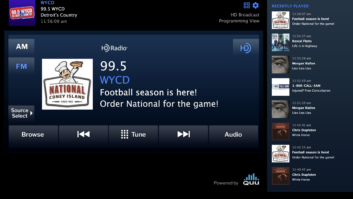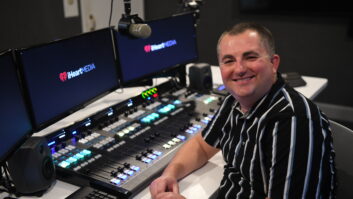
Credit: Getty Images/Westend61
What are sales executives telling the advertising community about audio technology and how radio fits into it? This post from the Radio Advertising Bureau provides insight.
Technology! It enables us to do things quickly and gives us capabilities to do stuff that we could never do before. Technology provides us with choice (arguably too much choice). It helps to save lives and exposes us to experiences and content never before dreamed possible. Technology gives us the ability to multi-task, makes us a smarter population, and it allows us to make informed decisions.
Technology is changing the game across all categories of business, making industry and local cities more productive and efficient while improving daily lives. Technology also risks making things more complicated and it is human impact that helps to simplify various aspects of innovation.
Thanks to technology, the audio landscape continues to evolve and innovate in meaningful ways. Consumers are leaning in to audio and they are listening to radio across all platforms with mass- and niche-targeted content available across devices with a simple touch of a button, a turn of a dial or an audible cue.
Technology allows radio and its listeners to engage and interact in real time, allows brands to plan smarter campaigns, and realize specific and attributable results.
So what is technology enabling in audio and how can marketers leverage what’s available today and prepare for tomorrow?
VOICE
Radio is audio and audio is sound. Voice is sound and sound is audio. Voice — it is opinion, attitude, expression, a means to convey desires, answers and so much more.
The power of voice continues to rise with the insurgence and adoption of AI-based technology. Consumers simply use their voice to garner a desired response — no need for a keyboard, no need for a button, just the sound of their voice and the proper audible cue (or command).
Today, consumers’ voices are louder than brand voices, and radio stations and their partners have a tremendous opportunity to ensure they’re delivering on the voice requests, desires and commands. Radio stations across the country are ensuring that listeners know how to ask a voice-activated device to play their favorite station or tune in to a specific radio broadcast. Radio is also the platform where brands have successfully established audio identities and driven calls to action.
Radio is the only mass-reaching, niche-delivering audio medium to establish sonic brands and audio cues. Not only are audio identities critical for brands in a voice-activated world, but according to a variety of studies outlined here (http://tinyurl.com/rw-rab-sonic), sonic branding connects our hearts and minds, familiar music cues generate memories, the speed of sound is faster than a visual and audio signatures have the ability to convey your brand’s emotions.
CONNECTED CAR
The automobile presents a highly unique experience in that drivers and passengers are extremely captive audiences, and an audience that now has the ability of choice — bringing their owned entertainment into the vehicle or make use of what is provided to them.
Radio is and always has been the foundation of infotainment in the vehicle and continues to capitalize on the rich opportunity to expand upon technological advancements for broadcast and compelling, original and local content that people want to listen to.
Radio’s in-dash experience is changing — there are advancements in HD Radio allowing for a richer and more robust content experience. With voice controls, the driver can easily request where to tune in and the possibilities to act on advertising are becoming quite real. Imagine hearing an ad on the radio and using voice to tell your vehicle to drive you there, or hear an ad on the radio and ask for the information to be sent to your smartphone via SMS or text.
MEASUREMENT
Today, metrics and optimization opportunities that were previously only available in the digital space are available from radio broadcasters as well as a wide breadth of data and research partners who are proving not only radio’s reach but also its ability to drive a return on specific ad spend.
The radio industry is making investments and adopting technology to continually improve audio products and the platforms for which they are consumed and transacted. For the consumer, radio is about being wherever and whenever the consumer wants it, and for advertisers it is about making it easier to plan, buy and utilize data.
[HD Radio, FEMA Demo Emergency Notification Capabilities]
Marc Pritchard, chief brand officer for Procter & Gamble, spoke with Jeff Schmidt, RAB’s SVP professional development, at CES 2019 and confirmed that P&G is trying to leverage technology and analyze and interpret data to constructively lead disruption. They are trying to eliminate the waste out of mass media to reach people on a one-to-one basis only when they want to be reached.
Pritchard shared that they are finding that radio is becoming far more data-driven, -analytics driven and -programmatically driven, which is enabling P&G brands to find ways to reach consumers in a far more effective way and on a real local scale as well.
PODCASTING
If you haven’t experienced podcasts yet, take it from Conal Byrne, president of iHeartPodcast Network, who said, “The first time people discover podcasts, it’s like peeking into a room that you didn’t know was there, and it’s like finding gold.”
Podcasting has enabled radio to do what it does best: tell stories, share conversations, inform, educate and entertain in a longer format and on-demand with relevance across a variety of niche subject matter.
Growth of audience over the next couple of years is inevitable, and the benefit of a brand partnering with a radio broadcaster that operates in the podcasting space is the ability to also produce, distribute and promote podcast content on broadcast radio. It offers greater scale and a wider breadth of opportunities for both the advertiser and the podcast content.
PROGRAMMATIC
Programmatic capabilities, more specifically, enhanced targeting and automated/rep assisted planning and buying, are key to enabling the broadcast radio industry and medium to grow and better serve advertising partners.
Platforms that include iHeartMedia’s SmartAudio and Expressway by Katz, among others, now enable advertisers to connect to prime broadcast radio inventory swiftly and efficiently while creating smart, customized and targeted campaigns. And it’s working.
ALL ABOUT EXPERIENCES
Last but not least, technology is enhancing radio’s hardware — in addition to the smartphone, tablet, smart speaker or the Amazon Echo Spot (that looks like a clock radio), there are many companies building radios the way listeners want and need to use them.
ION Audio, for example, is all about experiences and enabling consumers to take sound wherever they go. They have built product designed for the DIYer, the swimmer (Wave Rider Max that can not only submerge in the water, but has cup-holders to hold your beer and lights to light up the pool at night) and the survivalist (a device that charges with a crank in the event of a power outage — every home in America should have this device!)
Indeed, technology is everywhere and audio tech is no exception, providing advertisers the opportunity to innovate, build brands and drive results.
This commentary appeared in the Radio Advertising Bureau newsletter “Matter Of Fact.” Sign up for it at www.rab.com/whyradio.
Radio World welcomes comments on this or any article. Email radioworld@futurenet.com with “Letter to the Editor” in the subject field.







